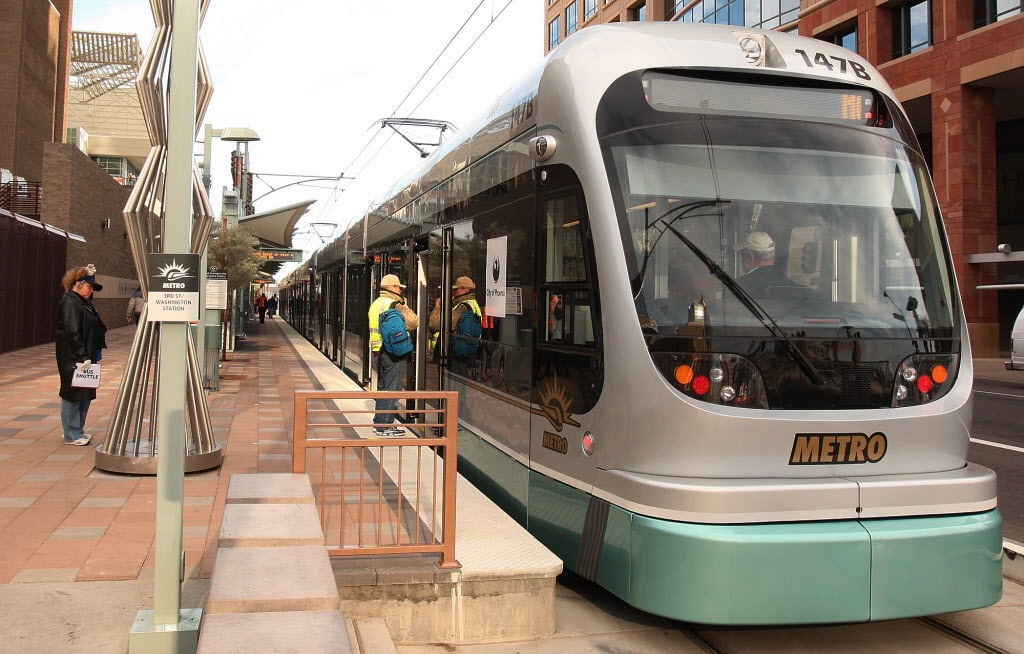PHOENIX — House Republicans trotted out their own version of a new transit tax for Maricopa County on Monday, one that doesn't match what Democratic Gov. Katie Hobbs wants.
But it remains unclear whether they can line up the votes for it.
The House plan, like the one Hobbs negotiated with the Maricopa Association of Governments, would set the stage for a public vote sometime next year to decide whether the half-cent levy, first approved in 1985, should get another 20-year extension.
But that's where the similarities end. And much of the hang-up is on light rail.
What Hobbs wants is a single vote on the package designed to raise $20 billion over the next two decades.
It's not a blank check. Instead, under her plan, 40% of the funds would go to freeway construction, with another 22% for regional and arterial roads, with 38% for transit.
And Hobbs agreed that none of the transit dollars could be used to extend the light rail system beyond what already is built, under construction or planned with existing funds.
Not good enough, House GOP leader say.
They want two separate ballot questions.
The first would allocate about 86% of the funds raised to pay for freeways, main roads and buses, with nearly half of those dollars allocated specifically to building more highways.
The remaining 14%, to rehabilitate existing light rail lines and build extensions, would be dependent on voter approval of a second, separate question.
The hostility toward light rail among some GOP lawmakers is deep. In fact, the plan they advanced Monday would block extending the system to the state Capitol — a project that already has funds set aside in the existing levy — regardless of whether either or both ballot measures passed.
Avondale Mayor Kenn Weise, who chairs MAG, said he was blindsided by the new proposal.
"You caught me a little bit of a loss because I didn't quite expect that,'' Weise said when told of the new proposal. "The splitting it, the bifurcation of this bill, has not come up in any discussions that we have with Senate and House leaders.''
The problem goes beyond the two-tiered vote, he told Capitol Media Services.
He said the new proposal could put at risk $16 billion in federal funding because the plan would no longer meet co-called "conformity'' rules, including requirements to address air quality.
The GOP proposal is built on the premise that a majority of Maricopa County voters, while they may support more miles of road and more bus service, have little interest in light rail — and not only because it does not serve where many of them live.
There's also the huge capital cost of tearing up roads, installing rails and putting in the overhead power lines. The 5.5-mile extension along Phoenix's South Central Avenue alone has an estimated $1.35 billion price tag.
Weise, however, said MAG doesn't see it that way, suggesting that splitting the vote could put the entire plan in jeopardy of not passing.
"It's the light rail portion that garners a lot of support,'' Weise said. "The people who vote, vote for light rail.''
He cited multiple elections where voters overwhelmingly backed train service in metro Phoenix.
But his real frustration is that the Republicans who control the Legislature appear convinced that voters do not want the plan negotiated with Hobbs — but haven't given it a chance.
"Why not just submit the plan as presented by MAG and supported by the governor and let the voters decide on what they want to do?'' he said. "Why have two different ballot initiatives on this? It's frustrating.''
It's not just funding for light rail that separates what Hobbs and MAG want from the proposal introduced by GOP leaders on Monday.
Lawmakers want to shift about $1 billion now earmarked for bike lanes, pedestrian paths and air quality programs into what they called "actual road projects.'' They also want an absolute ban on "road diets,'' or shrinking the number of lanes on highways in a way to discourage people from driving.
The GOP plan also calls for allowing the Legislature to appoint people from industry to the MAG board, which makes decisions on projects to pursue within the broader guidelines of how the money can be spent. MAG now is composed of mayors and other elected officials.
The Republican legislation also seeks to require Valley Metro, which operates the buses and light rail, to "achieve peer benchmarks'' with other cities in how much of the cost is borne by actual riders.
That figure — and which communities would be used for comparison — was not defined in information released on Monday. But Sen. David Farnsworth, R-Mesa, said the current figure for Valley Metro is that fares cover just 7 1/2 cents of actual operating costs.
If the system can't match those in similar cities, then Valley Metro would need to outsource operations to the private sector.
For the moment, Hobbs is not budging from her support for what she worked out with MAG.
"We're sticking to our negotiating position,'' said her spokesman Christian Slater, though he said she is willing to consider changes.





